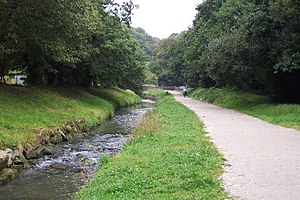St Austell River

The St Austell River runs for is eight miles through the midst of Cornwall, through its largest town, St Austell and out to the county's south coast on the English Channel
Name
The river is named today after St Austell, through which town it runs. It has also been known as the "Red River" due to tin streaming and mining activity upstream, which turned its waters red.
The name 'River Vinnick' was used historically and in Cornish it has been known as Dowr an Wynyk, meaning the little white river, and in English too it was once known as 'The White River'.
The local term White River has given its name to the St Austell Town Centre Redevelopment Scheme, which is now called White River Place.
The course of the river
The river drains the central southern section of the St Austell Moorland, an upland formed in the Variscan orogeny, to the north of St Austell, and the largest granite mass in Cornwall after Bodmin Moor. The highest natural point of the moorland is Hensbarrow Beacon at {{convert|312|m|ft|x|0}, though modern china clay mining waste tips now rise above it.
The river has two main tributaries, the first of which begins several hundred yards south of Hensbarrow Beacon at SW991550 and heads south east past the southern edge of Gunheath china clay pit.
At Carthew, the river heads south and passes Ruddlemoor and Trethowel in the Trenance Valley, where several mills and blowing houses made use of the river. This is a steep sided ‘V’ shaped valley carved through granite. A number of very minor tributaries enter this section, including springs and adits/levels at Gunheath, Lansalson, and Bojea. At the end of the Trenance Valley the river passes under the Cornish Main Line railway and enters St Austell.
The second tributary begins within the massive Littlejohn's/Dorothy china clay pit in a region that was originally known as Longstone Moor, where previously it had been a long, shallow valley that had drained the surrounding high moorland area. It travels southwards beneath a massive waste tip, whence it issues from a culvert at the head of the Gover Valley and the base of the tip. From there, it winds roughly south until it too reaches another viaduct belonging to the Cornish Main Line railway, wherefrom it turns east southeast and follows this heading for approximately a kilometre into St Austell, where it joins the Trenance Valley river.
Once leaving St Austell the river flows south along the Pentewan Valley, which extends for three miles, to the village of Pentewan, where the river enters the English Channel. The final section of the river can vary course significantly as it crosses Pentewan beach and flows into the sea at SX020470.
History
Before the Industrial Revolution, wastewater from nearby china clay quarrying and refining activity was emptied into the river, resulting in a white colour and the local name 'White River'. However, the Industrial Revolution brought to the area large-scale tin streaming and shallow lode-back mining, which altered the colour of waters from white to to red, and this deepened as greater mechanization was introduced and larger volumes of tin and material were mined.
Waste from the upstream mining practices resulted in silting at the mouth of the river, at the port of Pentewan, the point of export for the products of the upstream industry. Industry in the area cycled between tin mining and china clay until the middle of the 20th century, at which point the accumulated deposits from decades of mine waste, sand and mica permanently silted the port, dividing the harbour basin from the sea and ending exports from Pentewan.
Today, the tin mines have closed and the china clay industry has ceased its fouler ways, and the river waters run clear to the sea.
See also
Outside links
| ("Wikimedia Commons" has material about St Austell River) |
- Location map: 50°20’13"N, 4°47’35"W
- St Austell Stream or White River; Cornwall Rivers Project
